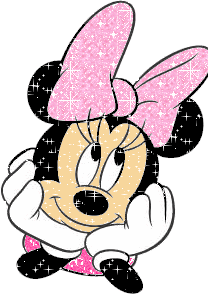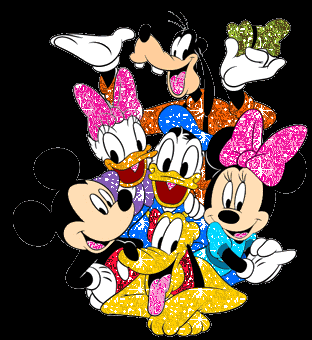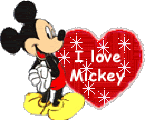
Mickey Mouse is a comic animal cartoon character who has become an icon for The Walt Disney Company. Mickey Mouse was created in 1928 by Walt Disney and Ub Iwerks[1] and voiced by Walt Disney. The Walt Disney Company celebrates his birth as November 18, 1928 upon the release of Steamboat Willie.[2] The anthropomorphic mouse has evolved from being simply a character in animated cartoons and comic strips to become one of the most recognizable symbols in the world.
Roles and design
Mickey as a suitor
The Barn Dance, first released on March 14, 1929, was the first of twelve Mickey shorts released during that year. It was directed by Walt Disney with Ub Iwerks as the head animator. This short is notable for featuring Mickey turned down by Minnie in favor of Pete. It is also an unusual appearance of the Pete character; previously depicted as a menacing villain, he is portrayed here as a well-mannered gentleman. In addition, Mickey was not depicted as a hero but as a rather ineffective young suitor. In his sadness and crying over his failure, Mickey appears unusually emotional and vulnerable. It has been commented, however, that this only serves to add to the audience's empathy for the character.
First gloved appearance
"Ever wonder why we always wear these white gloves?" - Various characters (with minor variations)
Mickey in gloves.
The Opry House, first released on March 28, 1929, was the second short released during the year. This short introduced Mickey's gloves. Mickey can be seen wearing them in most of his subsequent appearances. Supposedly one reason for adding the white gloves was to allow audiences to distinguish the characters' hands when they appeared against their bodies, as both were black (Mickey did not appear in color until The Band Concert in 1935). The three black lines on the backs of the gloves represent darts in the gloves' fabric extending from between the digits of the hand, typical of kid glove design of the era.
Depiction as a regular mouse
When the Cat's Away, first released on April 18, 1929, was the third Mickey short to be released that year. It was essentially a remake of one of the Alice Comedies, Alice Rattled by Rats, which had been first released on January 15, 1926. Kat Nipp makes his second appearance, though his name is given as "Tom Cat" (this describes his being a tom cat, and the character should not be confused with the co-star of the Tom and Jerry series). He is seen getting drunk on alcoholic beverages. Then he leaves his house to go hunting. In his absence an army of mice invade his house in search of food. Among them are Mickey and Minnie, who proceed to turn this gathering into a party. This short is unusual in depicting Mickey and Minnie as having the size and partly the behavior of regular mice. The set standard both before and after this short was to depict them as having the size of rather short human beings. On another note, it has been commented that[weasel words] since this short was released during the Prohibition era, the alcoholic beverages would probably have been products of bootlegging.[citation needed]
Also in the live action segments of The Hot Choc-late Soldiers from 1934, an animated Mickey Mouse not much bigger than a normal mouse interacts with Jimmy Durante.
Mickey as a soldier
The next Mickey short to be released is also considered unusual. It was The Barnyard Battle, first released on April 25, 1929. This short is notable as the first to depict Mickey as a soldier and the first to place him in combat.
Mickey's design
The character has gone through some major changes through his existence. The first one happened with The Pointer in 1939, where he got more realistic eyes, skin colored face and pear-shaped body. In the 40's, he changed once more in The Little Whirlwind, where he used his trademark pants for the last time in decades, lost his tail, got more realistic ears that changed with perspective and a different body anatomy. But this change would only last for a short period of time before returning to the one in The Pointer, with the exception of his pants. In his final cartoons in the 50's, he also got eyebrows, which were removed in the more recent cartoons.
The Barn Dance, first released on March 14, 1929, was the first of twelve Mickey shorts released during that year. It was directed by Walt Disney with Ub Iwerks as the head animator. This short is notable for featuring Mickey turned down by Minnie in favor of Pete. It is also an unusual appearance of the Pete character; previously depicted as a menacing villain, he is portrayed here as a well-mannered gentleman. In addition, Mickey was not depicted as a hero but as a rather ineffective young suitor. In his sadness and crying over his failure, Mickey appears unusually emotional and vulnerable. It has been commented, however, that this only serves to add to the audience's empathy for the character.
First gloved appearance
"Ever wonder why we always wear these white gloves?" - Various characters (with minor variations)
Mickey in gloves.
The Opry House, first released on March 28, 1929, was the second short released during the year. This short introduced Mickey's gloves. Mickey can be seen wearing them in most of his subsequent appearances. Supposedly one reason for adding the white gloves was to allow audiences to distinguish the characters' hands when they appeared against their bodies, as both were black (Mickey did not appear in color until The Band Concert in 1935). The three black lines on the backs of the gloves represent darts in the gloves' fabric extending from between the digits of the hand, typical of kid glove design of the era.
Depiction as a regular mouse
When the Cat's Away, first released on April 18, 1929, was the third Mickey short to be released that year. It was essentially a remake of one of the Alice Comedies, Alice Rattled by Rats, which had been first released on January 15, 1926. Kat Nipp makes his second appearance, though his name is given as "Tom Cat" (this describes his being a tom cat, and the character should not be confused with the co-star of the Tom and Jerry series). He is seen getting drunk on alcoholic beverages. Then he leaves his house to go hunting. In his absence an army of mice invade his house in search of food. Among them are Mickey and Minnie, who proceed to turn this gathering into a party. This short is unusual in depicting Mickey and Minnie as having the size and partly the behavior of regular mice. The set standard both before and after this short was to depict them as having the size of rather short human beings. On another note, it has been commented that[weasel words] since this short was released during the Prohibition era, the alcoholic beverages would probably have been products of bootlegging.[citation needed]
Also in the live action segments of The Hot Choc-late Soldiers from 1934, an animated Mickey Mouse not much bigger than a normal mouse interacts with Jimmy Durante.
Mickey as a soldier
The next Mickey short to be released is also considered unusual. It was The Barnyard Battle, first released on April 25, 1929. This short is notable as the first to depict Mickey as a soldier and the first to place him in combat.
Mickey's design
The character has gone through some major changes through his existence. The first one happened with The Pointer in 1939, where he got more realistic eyes, skin colored face and pear-shaped body. In the 40's, he changed once more in The Little Whirlwind, where he used his trademark pants for the last time in decades, lost his tail, got more realistic ears that changed with perspective and a different body anatomy. But this change would only last for a short period of time before returning to the one in The Pointer, with the exception of his pants. In his final cartoons in the 50's, he also got eyebrows, which were removed in the more recent cartoons.











